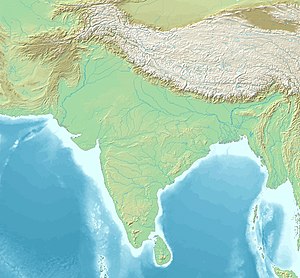Battle of Peshawar (1001)
 From Wikipedia - Reading time: 5 min
From Wikipedia - Reading time: 5 min
| Battle of Peshawar | |||||||||
|---|---|---|---|---|---|---|---|---|---|
| Part of the Ghaznavid campaigns in India | |||||||||
| |||||||||
| Belligerents | |||||||||
|
| Hindu Shahi | ||||||||
| Commanders and leaders | |||||||||
|
| Jayapala (POW) | ||||||||
| Strength | |||||||||
| 15,000 cavalry |
12,000 cavalry 30000 infantry 300 elephants | ||||||||
Location within South Asia | |||||||||
The Battle of Peshawar was fought on 27 November 1001 between the Ghaznavid army of Mahmud of Ghazni and the Hindu Shahi army of Jayapala, near Peshawar. Jayapala was defeated and captured, and as a result of the humiliation of the defeat, he later immolated himself in a funeral pyre. This is the first of many major battles in the expansion of the Ghaznavid Empire into the Indian subcontinent by Mahmud.
Background
[edit]In 962, Alp-Tegin, a Turkic ghulam or slave soldier, who rose to be the commander of the army in Khorasan in the service of the Samanids, seized Ghazna and set himself up as a ruler there. In 997, Mahmud ascended the throne at Ghazni, a successor to Sabuktigin, Mahmud started to vigorously expand his domain, and vowed to invade India every year until the northern lands were his.[1] In 1001 he arrived at Peshawar with a select group of 15,000 cavalry, and a large corps of ghazis and Afghans.[2] This began a struggle with the Hindu Shahi kingdom which extended from Laghman to Kashmir and from Sirhind to Multan.[3][2] The Hindu Shahi ruler Jayapala attacked the Ghaznavids, but was defeated, then again later when his army of a reported size of over 100,000 was beaten.[4] The territories were annexed by the Ghaznavids.
Battle
[edit]An account of the battle between the invading Turkic Ghaznavids and the Shahi kingdom was given by Al-Utbi in Tarikh Yamini.[5] According to Al-Utbi, Mahmud pitched his tent outside the city upon reaching Peshawar. Jayapala avoided action for some time waiting for reinforcements, and Mahmud then took the decision to attack with swords, arrows, and spears. Jayapala moved his cavalry and elephants to engage his opponent, but his army was decisively defeated.[6]
According to the sources, Jayapala, along with members of his family were captured, and valuable personal adornments were taken off the prisoners, including a necklace of great value from Jayapala. The number of Hindu dead ranged from 5,000 to 15,000,[6][7] and five hundred thousands were said to have been taken captive. Judging from the personal adornments taken off captured Hindus, Jayapala's army was not prepared for battle and thousands of children were taken captive as well.[8]
Aftermath
[edit]Jayapala was bound and paraded, and a large ransom was paid for the release of members of his family. Jayapala felt the defeat to be a great humiliation, and later he built himself a funeral pyre, lit it, and threw himself into the fire.[9]
Mahmud later conquered the upper Indus region, and then in 1009, defeated Jayapala's son Anandapala in a battle at Chach. He then captured Lahore and Multan, giving him control of the Punjab region.[2]
See also
[edit]References
[edit]- ^ Susan Wise Bauer (2010). The History of the Medieval World: From the Conversion of Constantine to the First Crusade. W. W. Norton & Company. ISBN 978-0-393-05975-5.
- ^ a b c Satish Chandra (2004). Medieval India: From Sultanat to the Mughals-Delhi Sultanat (1206–1526) Part 1 (3rd ed.). Har-Anand Publication Pvt Ltd. pp. 17–18. ISBN 8124105227.
- ^ "AMEER NASIR-OOD-DEEN SUBOOKTUGEEN". persian.packhum.org. 5 March 2016. Archived from the original on 5 March 2016. Retrieved 9 April 2023.
- ^ Sir H. M. Elliot (1869). "Chapter II, Tarikh Yamini or Kitabu-l Yamini by Al Utbi". The History of India, as Told by Its Own Historians. The Muhammadan Period. Trubner and Co. pp. 18–24.
- ^ Pradeep Barua (2006). The State at War in South Asia. University of Nebraska Press. p. 25. ISBN 0-8032-1344-1.
- ^ a b Sir H. M. Elliot (1869). "Chapter II, Tarikh Yamini or Kitabu-l Yamini by Al Utbi". The History of India, as Told by Its Own Historians. The Muhammadan Period. Trubner and Co. pp. 24–26.
Swords flashed like lightning amid the blackness of clouds, and fountains of blood flowed like the fall of setting stars. The friends of God defeated their obstinate opponents, and quickly put them to a complete rout. Noon had not arrived when the Musulmans had wreaked their vengeance on the infidel enemies of God, killing 15,000 of them, spreading them like a carpet over the ground, and making them food for beasts and birds of prey. Fifteen elephants fell on the field of battle, as their legs, being pierced with arrows, became as motion-less as if they had been in a quagmire, and their trunks were cut with the swords of the valiant heroes.
- ^ Captain G. Roos-Keppel, Qazi Abdul Ghani Khan (1906). Translation of the Tarikh-i-Sultan Mahmud-i-Ghazvani. Anglo-Sanskrit Press.
Sultan Mahmud behaved bravely and victory fell to him, he became famous as a Ghazi; and he captured Jaipal with fifteen men, who were some his sons and some his relations, and he killed five thousand Hindus and brought back much plunder.
- ^ Early Aryans to Swaraj, Vol. 6, Ed. S.R.Bakshi, S.Gajrani and Hari Singh, (Sarup & Sons, 2005), 25.
- ^ Sir H. M. Elliot (1869). "Chapter II, Tarikh Yamini or Kitabu-l Yamini by Al Utbi". The History of India, as Told by Its Own Historians. The Muhammadan Period. Trubner and Co. p. 27.
When Jaipal, therefore, saw that he was captive in the prison of old age and degradation, he thought death by cremation preferable to shame and dishonour. So he commenced with shaving his hair off, and then threw himself upon the fire till he was burnt
 KSF
KSF
